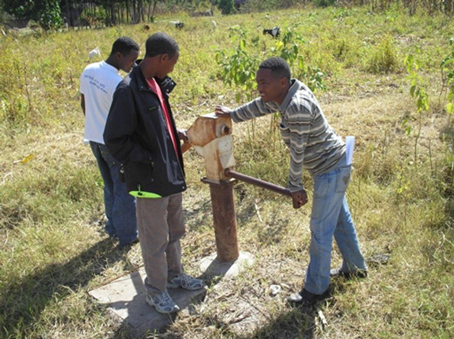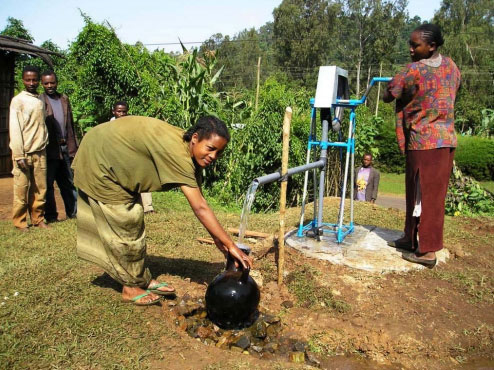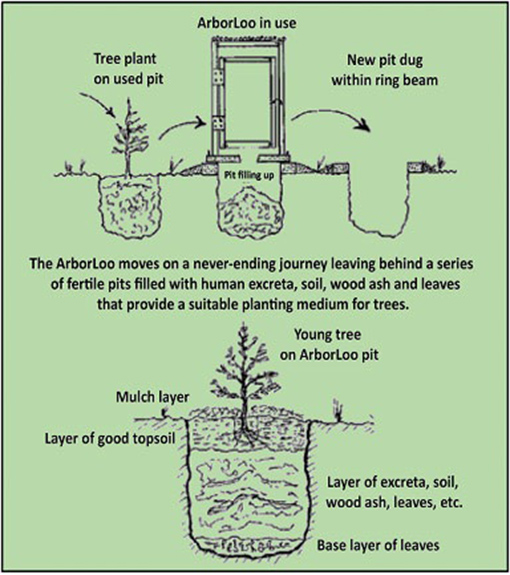6.2.1 Rural water supply
Based on the Ethiopian Water Resources Management Policy (WRMP) of 1999 (which you read about in Study Session 2), the rural water supply sub-component of the OWNP emphasises decentralised management as well as integrated and participatory approaches to implementation. The WRMP also specified that rural water supply schemes should ensure the recovery of operation and maintenance costs. (Operation and maintenance or O&M, refers to all the activities required to keep a service functional. O&M costs are the running costs that will continue over time, as opposed to capital costs which refer to the initial costs of installing a new service. Recovery of O&M costs means that users of a service should pay enough money to cover all the running costs through a consented water tariff system. Water tariff is the price paid by consumers for water.)
In Ethiopia, sustaining water supply services over time is a major challenge. In many cases, after a short period of service, schemes fail due to technical faults and lack of maintenance (Figure 6.1). Studies have shown that about 30% of water supply schemes are non-functional, mostly because of minor problems.

The missing element that frequently could have prevented failure is the establishment of a local operation and maintenance (O&M) system at community or village level that could find ways to recover the O&M costs.
The OWNP aims to address this and other problems for this sub-component through the following main activities:
- Studies on different issues of water supply, e.g. feasibility studies, situational analysis.
- Development and construction of new point sources and small piped schemes with distribution systems, including multi-village schemes. (Point sources of water supply include hand-dug wells and protected springs which are accessed at the source. Small piped schemes are water systems with a piped extension from the source for distribution. Users do not access water at the source but far away at the distribution point. Multi-village schemes extend from a single common source to many villages located around it, with separate distribution points for each village.)
- Rehabilitation of existing point sources.
- Expanding small piped schemes.
The first of these activities focuses on studies such as feasibility studies and situational analysis. You may be wondering how studies can contribute to the success of the rural water supply sub-component of the OWNP. A feasibility study is conducted before the construction of the water supply scheme to discover if the construction is technically possible and can be achieved at reasonable cost. It would also evaluate whether or not the amount of water from the intended scheme is sufficient for the community. Situational analysis means a critical review of all aspects of a current situation in order to inform planning and decision making. For WASH schemes this involves assessing population numbers and distribution, socio-economic status, local geography, existing WASH services and usage, and so on. Undertaking studies of this type and applying study results appropriately can help to define programmes more precisely in order to make them more effective in terms of achieving targets, and efficient in the proper use of resources (money, personnel and time).
The rural water supply sub-component of the OWNP includes clearly defined implementation modalities. Modality means the way or ‘mode’ in which something is done or, in other words, an approach or procedures followed to carry out a certain task. The implementation modalities are:
- Woreda-managed project (WMP) modality
- Community-managed project (CMP) modality
- NGO-managed modality
- Self-supply modality
- Multi-village water supply schemes.
Each of these modalities is described in more detail in Study Session 10. For now, we will simply provide brief introductions.
Woreda-managed project modality
For this mode of implementation, the Woreda WASH Team (WWT) plays the leading role in all aspects of project management. The WWT carries out its leadership role in close collaboration with kebele administration and community WASH Committees (WASHCOs). (Woreda WASH Teams and WASHCOs were established by the 2006 WASH Memorandum of Understanding (MoU). You will learn more about these and other aspects of the organisational structure for WASH in the next study session.)
Community-managed project modality
This implementation modality relies on community members, particularly WASHCOs. The distinguishing feature of this modality is that it enables communities to fully own their water supply projects, which consequently ensures sustained service. This modality mainly focuses on the development of low-cost and small-scale schemes such as hand-dug wells and springs.
Why would ownership of the water supply, such as a well and hand pump, be empowering for a community?
If the community owns the well and pump they will take pride in looking after it and ensuring it is well maintained. The collaboration required in managing the pump and the collective decision making and actions of the WASHCO is likely to strengthen relationships between community members and encourage collaboration on other matters.
NGO-managed modality
Non-governmental organisations (NGOs) are important actors in the WASH sector. (You will find more details about their role as stakeholders in Study Session 9.) Many NGOs pioneer new innovations in terms of WASH technologies and implementation approaches. To give some examples of NGO modality, Plan International is known for using the community-led total sanitation and hygiene (CLTSH) technique, JICA and WaterAid for promoting rope pumps (see Figure 6.2) and CRS-Ethiopia for the innovative latrine technology called the ArborLoo (see Figure 6.3).


Self-supply modality
Self-supply means the construction and use of small-scale water schemes at household level, such as hand-dug wells, and is particularly appropriate in rural areas.
Multi-village water supply schemes
Some water schemes may have the potential to be used by a cluster of villages. If a thorough feasibility study confirms that the source is adequate and that the design and construction of a water supply system can address multiple villages sustainably, this modality will be considered.
6.2 Rural WASH
